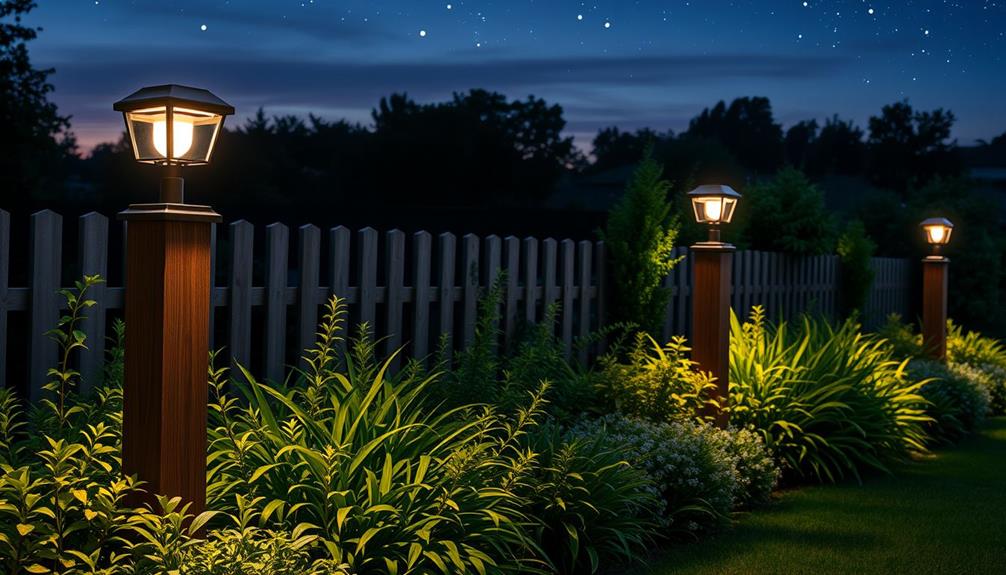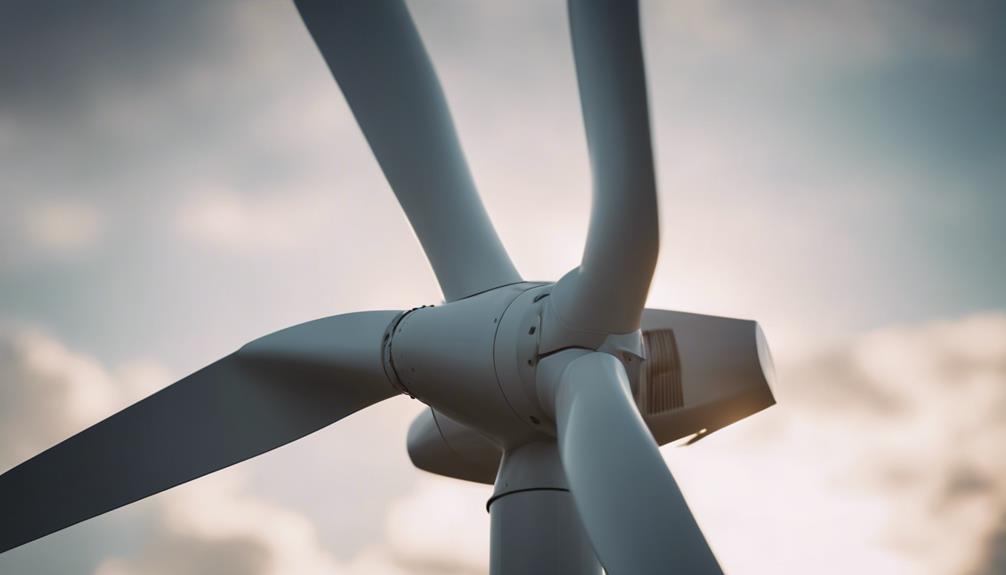Mooring lines are essential for keeping your boat secure against wind, currents, and waves. You'll want at least four lines: bow, stern, and two spring lines, ensuring they exceed your vessel's weight with a safety margin of 3:1. Choose high-quality materials like polyester for durability and UV resistance. Proper sizing is vital, with bow and stern lines being at least half your boat's length. Regular inspections for wear and maintenance can extend their lifespan. By focusing on the right techniques and materials, you can enhance your boating experience considerably. There's plenty more to explore as you look into this topic!
Key Takeaways
- Use at least four mooring lines (bow, stern, and two spring lines) to secure your vessel against drift from wind and currents.
- Choose high-quality materials, like polyester, for superior strength, UV resistance, and durability.
- Ensure mooring lines have a breaking strength exceeding your vessel's weight by a 3:1 safety margin.
- Regularly inspect lines for wear, UV damage, and replace them as needed to maintain safety.
- Implement chafe guards to protect lines from abrasion and extend their lifespan in harsh marine conditions.
Importance of Mooring Lines
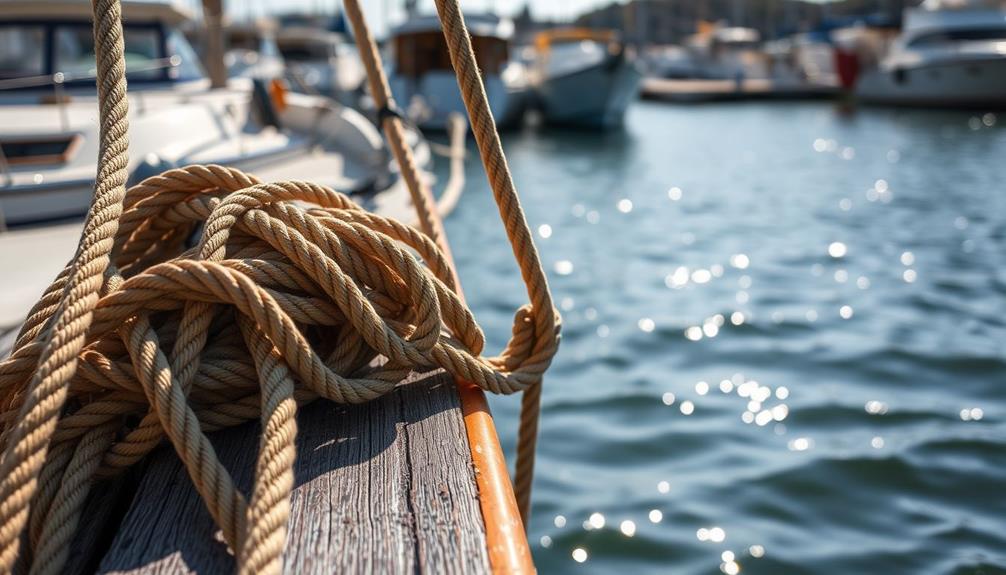
Why are mooring lines so important for your boating experience? As a boat owner, you know that securing your vessel properly is essential to prevent it from drifting due to wind, currents, and waves.
Quality mooring lines offer the good abrasion resistance you need to withstand harsh marine environments, similar to how New England offers diverse tent camping locations. Without them, your boat could suffer extensive damage from improper securing.
To guarantee peak safety, you should use at least four mooring lines—bow, stern, and two spring lines. This creates a solid hold against forces that could push your boat off course.
It's also critical that the breaking strength of your mooring lines exceeds your vessel's weight by a safety margin of at least 3:1. This guarantees reliability under stress, especially during storms or heavy swells.
Investing in high-quality mooring lines, such as those crafted from durable polyester, can greatly enhance their lifespan. They're designed to resist UV exposure and environmental wear, providing peace of mind while you enjoy your time on the water.
In short, good mooring lines not only improve stability but also reduce the risk of collisions, making them indispensable for any boat owner.
Types of Mooring Lines

Understanding the types of mooring lines is just as vital as recognizing their significance in securing your vessel. Mooring lines come in various constructions, each offering unique benefits. The double braid is popular for its flexibility and strength, making it ideal for various conditions. The 3-strand plaited line is another option, known for its excellent grip and ease of handling. Finally, square plait lines provide a combination of durability and resistance to twisting.
Additionally, selecting a high-performance mooring line can guarantee reliability in various marine environments, similar to choosing the best heat pump for peak comfort and efficiency in your home enhanced temperature regulation.
When choosing a material for mooring, consider options like polyester, which boasts abrasion resistance and UV stability. Polyamide offers high elasticity, while polypropylene is a budget-friendly choice, though it has limitations in durability.
It's essential that your mooring lines are long enough—ideally 1.5 times the boat's length—to accommodate tide fluctuations and provide sufficient slack. Additionally, make sure that the breaking strength of your lines exceeds your vessel's weight by a safety margin of at least 3:1 to prevent failures during adverse conditions.
Specialty mooring lines with chafe guards or UV protectants can further enhance performance, particularly in challenging marine environments.
Strength and Material Considerations

When choosing mooring lines, you need to take into account the strength and material to guarantee safety and durability.
Understanding common financial terms related to investment in quality equipment is vital, as you should aim for a line that can handle at least three times your vessel's weight.
Additionally, pay attention to UV resistance, since some materials degrade quickly under sunlight, affecting their performance over time.
Material Strength Comparisons
Selecting the right material for your mooring lines is essential for ensuring safety and performance. When making material strength comparisons, you'll find that nylon, while highly elastic, deteriorates quickly under UV exposure, making it unsuitable for long-term use.
On the other hand, polyester stands out as the preferred option. It offers excellent strength, abrasion resistance, and superior UV resistance, ensuring durability even in harsh marine environments. Additionally, understanding the mastering the art of bug out bags can provide insights into the importance of choosing reliable materials in emergency situations.
Polypropylene might catch your eye for its budget-friendly price, but it stretches considerably and degrades faster in sunlight, making it less ideal for reliable mooring.
Remember, the diameter of mooring lines directly affects their breaking strength. Larger diameters generally provide enhanced strength and ease of handling, which is vital for securing your vessel effectively.
Choosing the right material is more than just about cost; it's about ensuring your boat remains secure no matter the conditions. So, weigh your options carefully and consider how each material's properties will impact your mooring lines' performance and longevity.
Prioritize safety and durability, and you'll have peace of mind on the water.
Breaking Load Guidelines
Breaking load guidelines are indispensable for ensuring the safety and security of your vessel. When selecting mooring lines, you should choose lines with a breaking strength that exceeds the weight of your boat by a safety margin of 3:1. This precaution accounts for environmental forces like wind and waves, providing adequate security.
Additionally, using high-quality materials in your mooring lines can greatly enhance their effectiveness and longevity, much like the benefits of airless paint sprayers in ensuring a smooth finish with less effort.
Material choice is essential. While nylon mooring lines offer high elasticity, they degrade quickly under UV exposure, making them less suitable for long-term use in sunny conditions. Polyester, on the other hand, is often preferred for its high strength, abrasion resistance, and superior UV resistance, enhancing the durability of your mooring lines in marine environments.
Don't overlook the importance of the correct diameter. Larger diameters generally correlate with higher breaking strengths, which greatly impacts overall safety and usability.
UV Resistance Importance
The integrity of your mooring lines hinges greatly on their UV resistance, especially in sunny environments where prolonged exposure can weaken materials like nylon. UV rays can degrade nylon over time, leading to reduced strength and a shorter lifespan of your lines. This makes it essential to take into account the material you choose for your mooring lines.
Understanding the potential side effects and interactions of different materials can help you make a more informed choice.
Polyester is highly recommended due to its superior UV resistance compared to nylon. It maintains its integrity in harsh sunlight, providing you with reliable performance even in sun-soaked conditions.
Regular inspections for signs of UV damage, like fading or brittleness, are vital to guarantee your mooring lines remain safe and dependable.
To enhance the durability of your lines, think about applying UV protectant sprays, which can greatly prolong their functional life in marine environments.
Additionally, investing in high-quality mooring lines with built-in UV resistance features can save you money in the long run by reducing maintenance costs and the need for frequent replacements.
Sizing and Length Guidelines

When it comes to sizing and length guidelines for mooring lines, verifying you have the right dimensions is essential for securing your vessel effectively. For bow and stern lines, aim for a length that's at least half the overall length of your boat; this guarantees stability and effective securing.
Additionally, taking into account the effectiveness of various securing systems, much like how the presence of security systems deters potential threats, having the right mooring lines can prevent unexpected mishaps. Spring lines are important as well—they should match or exceed the full length of your vessel to minimize lateral movement and swinging.
It's also smart to carry a longer line, about five boat lengths, for towing or when facing heavy conditions. This extra length gives you flexibility and guarantees you're prepared for unexpected scenarios.
When mooring to fixed docks, don't forget to take into account tide fluctuations; these can greatly affect the length of lines you'll need.
If you're unsure about the best sizing for your specific situation, consulting marine professionals can provide tailored recommendations based on your mooring conditions and vessel type. Proper sizing and length are critical components in confirming that your mooring setup keeps your boat secure and ready for your next adventure.
Durability and Environmental Factors
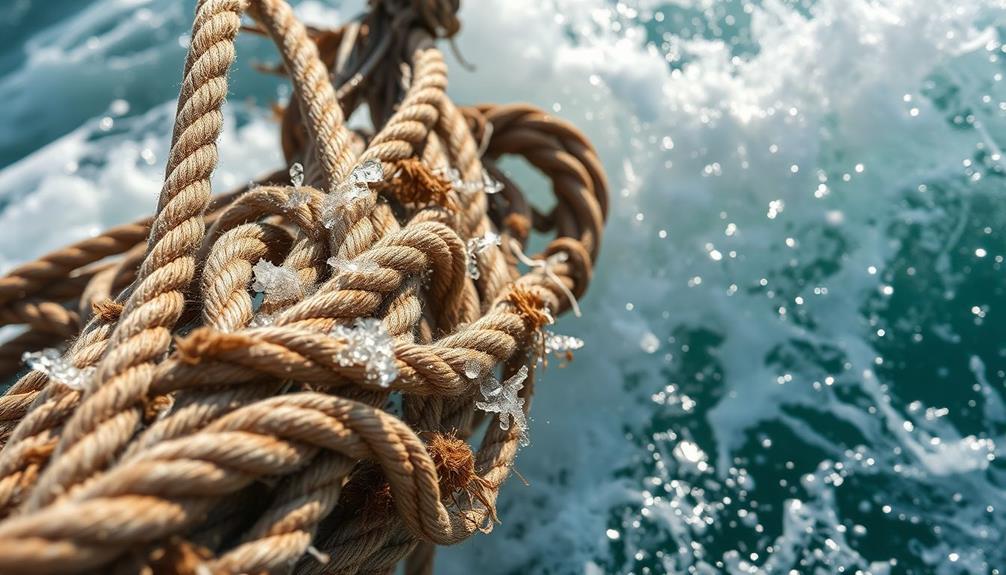
When it comes to mooring lines, considering UV resistance is vital for their longevity, especially in sunny climates.
Regular inspections can help identify any weaknesses, much like how maintaining air quality through regular air purifier maintenance can enhance the lifespan of your device.
You'll also want to invest in chafe guards to protect against wear from docks and pilings.
Regular maintenance and inspections can help you catch any signs of damage early, ensuring your lines remain reliable and safe.
UV Resistance Importance
Exposure to UV rays can dramatically impact the durability of mooring lines, making UV resistance a crucial factor in their performance and longevity. Most materials used for mooring lines weaken considerably under UV exposure, increasing the risk of failure. To guarantee your lines stay strong, consider using polyester mooring lines, which offer good UV resistance compared to nylon and polypropylene.
In sunny climates, you can enhance durability with regular use of UV protectant sprays. Alongside this, it's vital to conduct regular inspections of your mooring lines to catch any signs of UV damage, like fading or brittleness.
Here's a quick comparison of different mooring line materials:
| Material | UV Resistance | Recommended Action |
|---|---|---|
| Polyester | Good | Use for prolonged exposure |
| Nylon | Moderate | Inspect regularly |
| Polypropylene | Low | Avoid direct sunlight |
| UV Protectant | Enhances longevity | Apply regularly |
| Regular Inspections | Key | Check for fading and brittleness |
Chafe Guard Benefits
Protecting your mooring lines from abrasion is essential for their longevity, and that's where chafe guards come into play. These protective layers shield your lines from friction against docks, pilings, and other surfaces, considerably extending their lifespan.
Regular use of chafe guards can prevent the wear and tear that leads to degradation, especially in harsh marine environments. Investing in durable materials can also enhance your lines' performance, similar to how competitive pricing and transparent fee structure benefit precious metal investments.
When you invest in high-quality chafe guards, you're ensuring that the integrity of the fibers in your mooring lines is maintained. This helps your lines retain their strength and high elasticity over time, which is vital for safe boating.
In addition, chafe guards made from UV-resistant materials combat the weakening effects of sun exposure, further prolonging the usability of your lines.
Regular Maintenance Practices
Regular maintenance practices are essential for ensuring the longevity and reliability of your mooring lines. By committing to regular inspections and care, you can greatly enhance their lifespan and performance.
Here are some key practices to keep in mind:
- Conduct annual inspections for damage, chafing, and soiling.
- Clean mooring lines in a washing machine at 30°C or by hand, ensuring all detergent is rinsed out.
- Use UV protectant sprays to combat degradation in sunny climates.
- Implement chafe guards to prevent abrasion from docks and pilings.
Comfort and Handling Techniques

When mooring your boat, using the right techniques can make all the difference in comfort and ease of handling. Choosing braided docklines is essential, as their flexibility and smooth finish simplify manipulation during mooring. Additionally, using larger diameter lines not only enhances strength but also makes handling more user-friendly, especially with longer boats.
To prolong the life of your mooring lines, proper coiling and hanking techniques are crucial. This prevents tangling and wear, ensuring your lines remain reliable. Regular inspections for wear, such as checking for chafe and degraded fibers, help maintain safety and reliability.
Using chafe covers or lubricants reduces creaking noises and protects your lines from wear against docks and pilings. Here's a quick guide for selecting mooring lines based on your boat length:
| Boat Length | Recommended Line Diameter | Material | Handling Ease |
|---|---|---|---|
| Up to 20 ft | 3/8 inch | Braided Nylon | High |
| 20-30 ft | 1/2 inch | Braided Polyester | Very High |
| 30-40 ft | 5/8 inch | Double Braid | High |
| Over 40 ft | 3/4 inch | Polypropylene | Moderate |
Maintenance and Lifespan

Maintaining your mooring lines is key to guaranteeing their longevity and reliability. To get the most out of your mooring ropes, follow these essential maintenance tips:
- Inspect regularly: Check for damage, chafing, and soiling at least once a year. A thorough inspection can help prevent issues, much like how diversification of retirement portfolio enhances long-term financial security.
- Clean appropriately: Wash your mooring lines in a machine at 30°C or by hand, making sure to rinse out all detergent.
- Replace when necessary: If you spot any wear or damage, don't hesitate to replace your mooring lines.
- Consider usage: Choose the right rope length and diameter based on your boat's specifications and intended use.
Typically, the life span of mooring ropes is around 10 years, but this can shrink considerably with heavy use and poor maintenance practices.
To enhance durability, guarantee your lines are doubled during storms or when you'll be away for an extended period.
Safety Considerations
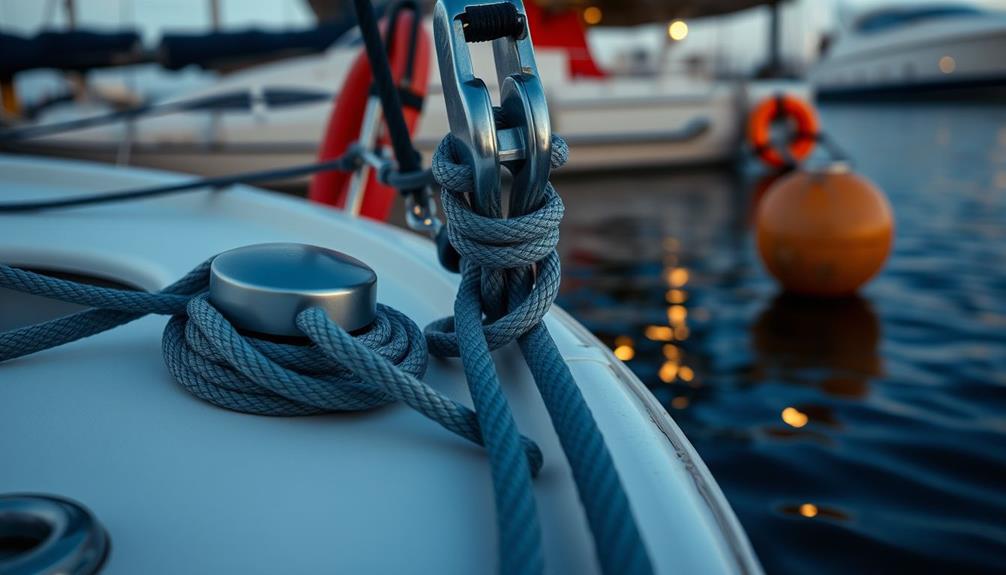
Safety considerations for mooring lines are crucial for protecting both your vessel and crew. Regularly inspect your mooring lines for wear, chafing, and UV degradation—at least once a year. This proactive approach helps you identify potential issues before they lead to failure.
In adverse weather conditions, utilizing shock absorbers in your mooring lines can greatly reduce strain on both your boat and the mooring equipment, enhancing overall safety.
Proper training in mooring techniques is essential. Understanding line handling and knot tying can decrease the risk of accidents and damage. Always verify that the breaking strength of your mooring lines exceeds your vessel's weight by a safety margin of at least 3:1. This extra strength helps mitigate risks from unexpected forces, like wind and currents.
Moreover, don't forget to use fenders during the mooring process. They protect your vessel from impacts and minimize the potential for structural damage over time.
Sustainable Mooring Options

Sustainable mooring options are transforming how boaters secure their vessels while being kind to the environment. By selecting eco-friendly mooring lines, you not only keep your boat safe but also contribute to meaningful marine conservation efforts.
Here are some benefits of these innovative solutions:
- Made from recycled materials, like rPET, reducing plastic waste
- High performance with strong breaking load and elasticity
- UV resistant for durability in various marine conditions
- Comparable lifespan to traditional lines, minimizing waste
Investing in sustainable mooring solutions means you're supporting recycling efforts and promoting environmental responsibility within the boating community.
Eco-friendly mooring lines are designed to withstand the rigors of marine environments while ensuring your vessel stays securely moored.
When you choose sustainable mooring options, you're making a conscious decision that benefits not just your boat, but also the oceans.
With the right eco-friendly materials, you can enjoy peace of mind knowing that your mooring practices align with a healthier planet.
Embrace these sustainable choices and take a stand for our marine ecosystems while keeping your boat safe and sound.
Frequently Asked Questions
How to Secure Mooring Lines?
To secure mooring lines, guarantee your bow and stern lines are half your boat's length. Use spring lines that match its length, select strong lines, and employ effective knots. Regularly inspect for wear and tear.
How Do You Secure a Boat on a Mooring?
Did you know that over 70% of boating accidents involve improper mooring? To secure your boat, use four lines: two for the bow and stern, plus spring lines. Check for wear and replace as needed.
What Is the Crucial Step for Safe Mooring?
The essential step for safe mooring is choosing lines with a breaking strength at least three times your boat's weight. This guarantees your vessel remains secure, even under stress from wind or current. Furthermore, it is crucial to regularly inspect the condition of your mooring lines, as wear and tear can weaken their strength over time. Be sure to replace any damaged or frayed lines promptly to maintain the safety and security of your boat while moored. Additionally, it is worth considering the use of high-quality Samson ropes, which have a long history of reliability and durability in the marine industry. Samson rope history attests to their proven track record in withstanding the rigors of mooring and anchoring, providing peace of mind for boat owners.
What Is the Purpose of the Mooring Line?
Mooring lines secure your boat to the dock, preventing drift from wind and currents. They absorb shock, protect your vessel's structure, and guarantee stability, minimizing risks of collisions and damage while keeping you safe.
Conclusion
In the grand tapestry of boating, mooring lines are the threads that keep your vessel secure. By choosing the right type, sizing it correctly, and maintaining it well, you're not just protecting your boat; you're ensuring your peace of mind on the water. Remember, a little care goes a long way—invest in quality mooring lines, and they'll serve you faithfully for years to come. So, hoist your sails with confidence, knowing your boat is anchored safely!

